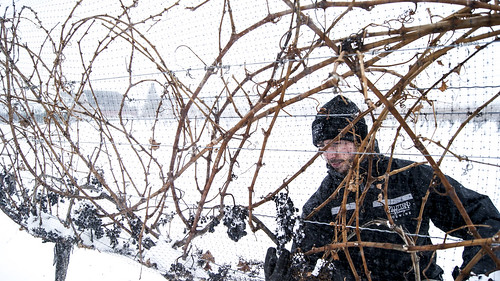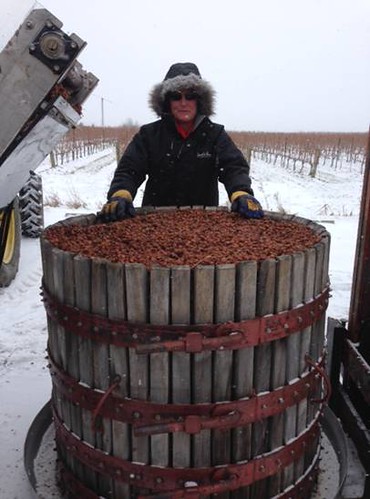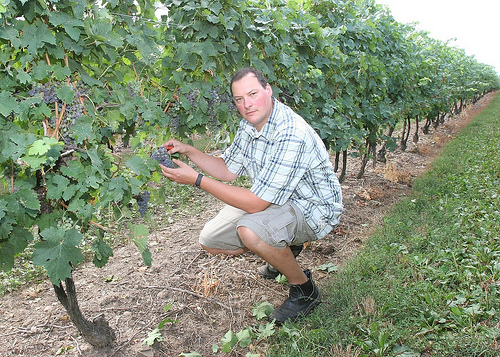
Note: It would appear icewine and late harvest wines have recovered from a downward trend since 2007.
With preliminary registrations for icewine and late harvest grapes showing 6,600 tonnes of grapes netted for the 2013 season, that’s a substantial increase from 2012’s 5,550 tonnes and reflects new plantings coming into production and the larger overall crop in 2013, according to VQA Ontario.
The year’s tonnage equals the previous record tonnage recorded in 2007. Icewine harvest got off to an early start with temperatures falling below -8C in all three appellations by Nov. 24 and has continued with the recent frigid temperatures.
One of Niagara’s largest icewine producers, Pillitteri Estates Winery, is reporting its largest ever harvest. Here is a news release issued by the Niagara-on-the-Lake winery. A Brock news release on VineAlert, a system for monitoring vine health during cold weather, follows the Pillitteri release.
Pillitteri Estates Winery completed their largest ever harvest of icewine grapes during a wild New Year’s winter storm.
A record icewine harvest for Pillitteri, which began in early December kicked in to high gear on New Year’s Day.
At 5 a.m. as the temperature reached -10C and the snow moved in to blanket the estate vineyards the Pillitteri team mobilized for a marathon finish.
It was the largest icewine harvest ever for Pillitteri and included the harvesting of rare icewine grapes including: Cabernet Sauvignon, Cabernet Franc, Gewurztraminer, Merlot, Shiraz and Riesling. The bulk of the Icewine harvest came from the popular Vidal grape with over 200 tonnes harvested.
The final stretch of the harvest primarily took place throughout the early morning of New Years Day and continued into the night with extreme challenges.
“With the amount of blowing and drifting snow and the depth of snow it was difficult to even get into the vineyards. The visibility was very poor and with the whiteouts, it was difficult to see the equipment and even the vines. Our tractors were slipping in the snow and we were constantly fighting the elements,” explained Jamie Slingerland (see top photo), Pillitteri’s Director of Viticulture.
This was a lengthy harvest, and one of the earliest completed for the winery, which finished the entire harvest by Jan. 2. It took many hours of dedicated work to complete, resulting in a total tonnage of 750 tonnes.
This year’s timely cold spells offered an excellent quality of juice, which will ultimately take up to two weeks to press and re-press for icewine and late harvest wines.
Much of the icewine produced is destined for China through a number of partnerships, which Pillitteri has recently established.
Many of the rarer icewines harvested will be sold exclusively at the winery’s retail store. Icewines such as Sangiovese, Merlot, Sauvignon Blanc and Chardonnay are only available at the Niagara-on-the-Lake winery and will be front and centre in this month’s upcoming Icewine Festival.
Pillitteri Estates Winery is a family owned and operated business founded in 1993 in Niagara-on-the-Lake. It currently exports to 32 countries and is the largest estate producer of Icewine in the world.
Pillitteri is the only certified Advantage HACCP Plus winery in Canada and has also received recognition for bringing the first certified “Verona” vines to Canada and for its work in appassimento wines.

Note: Inniskillin Winery, another prolific producer of icewine in Niagara and the Okanagan Valley, reported an early harvest for frozen grapes. This was a news release sent Dec. 14.
A frigid week has led us up to this morning’s icewine harvest at Inniskillin Niagara. Vineyard Director Gerald Klose and Inniskillin Winemaker Bruce Nicholson (photo above) decided to pick the Cabernet Franc and Riesling Icewine grapes from the Woerthler Vineyard (Line 4 at Concession 6), Niagara-on-the-Lake, starting at 3 a.m. and finishing around 8 a.m.
Bruce comments, “It is always nice to get these two vinifera varieties off before Christmas due to their thinner skin. The harvesting of the thicker skinned Vidal grapes allow for it to be picked later if needed while still maintaining good quantity and quality.”
Our earliest picking previously was Dec. 2, 2002 with our latest being March 5, 2001.
Last night’s temperatures reached -10C. Nicholson looks for -10 as his optimal icewine harvesting temperature. The desired sugar levels and acidities were reached.
The fall harvest was recently completed in mid November giving just under a month’s time for winery and viticulture staff a chance to rest before this morning’s Icewine Harvest.
Inniskillin Okanagan recently harvested Riesling icewine grapes on Nov. 21 for their earliest ever.
•••
Brock’s VineAlert program helps protect
vineyards during frigid temperatures

Note: With recent extreme cold weather, Brock issued this news release on its VineAlert program.
With extreme cold weather alerts across most of the province, Ontario vineyards are also feeling the chill. With next year’s grape crop at risk from the frigid temperatures, researchers at Brock University have issued a grapevine cold hardiness alert for growers across the province.
VineAlert, a program operated by Brock’s Cool Climate Oenology and Viticulture Institute (CCOVI), tracks a grape bud’s ability to survive cold temperatures over the dormant season from October to April. The alert system indicates at what temperature different varieties would see damage when cold weather events occur. This helps growers know when wind machines or other freeze avoidance methods are warranted to protect buds and vines from winter injury.
“In some regions, potentially damaging temperatures are in the forecast,” says CCOVI viticulturist Jim Willwerth (in photo above). “From our latest cold hardiness testing, the most sensitive cultivars (Merlot, Sauvignon blanc and Syrah) may sustain some freeze damage when temperatures drop below -19C.”
When cold hardiness monitoring shows a potential damaging event like the temperatures experienced this week, Willwerth and Kevin Ker, a CCOVI professional affiliate, alert growers to the danger through VineAlert’s notification system first.
Then after the cold event, they head to the vineyard to test grapevine bud survival.
“This bud survival knowledge is extremely valuable to grape growers,” Willwerth says. “If growers have not been able to prevent damage to the vines, winter injury can also be mitigated through pruning practices and adjustments in the vineyard that will allow for more consistent crops and reduce economic loss.”
VineAlert collects samples and monitors hardiness at 13 sites across the Niagara Peninsula, Lake Erie North Shore and Prince Edward County. Growers can specify their location and receive alerts when temperatures in their area approach the lowest temperatures grape buds can survive.
For the most recent cold hardiness data here.
For VineAlert’s cold hardiness alert for growers go here.






Comment here